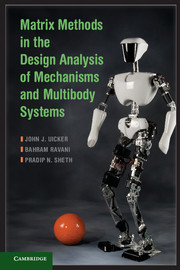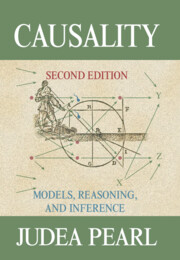Refine listing
Actions for selected content:
1372 results in Ebooks on robotics
16 - Impact Analysis
-
- Book:
- Matrix Methods in the Design Analysis of Mechanisms and Multibody Systems
- Published online:
- 05 April 2013
- Print publication:
- 15 April 2013, pp 300-309
-
- Chapter
- Export citation
2 - Topology and Kinematic Architecture
-
- Book:
- Matrix Methods in the Design Analysis of Mechanisms and Multibody Systems
- Published online:
- 05 April 2013
- Print publication:
- 15 April 2013, pp 22-41
-
- Chapter
- Export citation
Index
-
- Book:
- Matrix Methods in the Design Analysis of Mechanisms and Multibody Systems
- Published online:
- 05 April 2013
- Print publication:
- 15 April 2013, pp 321-326
-
- Chapter
- Export citation
8 - Acceleration Analysis
-
- Book:
- Matrix Methods in the Design Analysis of Mechanisms and Multibody Systems
- Published online:
- 05 April 2013
- Print publication:
- 15 April 2013, pp 197-224
-
- Chapter
- Export citation
Preface
-
- Book:
- Matrix Methods in the Design Analysis of Mechanisms and Multibody Systems
- Published online:
- 05 April 2013
- Print publication:
- 15 April 2013, pp xiii-xvi
-
- Chapter
- Export citation
Contents
-
- Book:
- Matrix Methods in the Design Analysis of Mechanisms and Multibody Systems
- Published online:
- 05 April 2013
- Print publication:
- 15 April 2013, pp vii-xii
-
- Chapter
- Export citation
7 - Velocity Analysis
-
- Book:
- Matrix Methods in the Design Analysis of Mechanisms and Multibody Systems
- Published online:
- 05 April 2013
- Print publication:
- 15 April 2013, pp 183-196
-
- Chapter
- Export citation
6 - Differential Kinematics and Numeric Solution of Posture Equations
-
- Book:
- Matrix Methods in the Design Analysis of Mechanisms and Multibody Systems
- Published online:
- 05 April 2013
- Print publication:
- 15 April 2013, pp 148-182
-
- Chapter
- Export citation
4 - Modeling Mechanisms and Multibody Systems with Transformation Matrices
-
- Book:
- Matrix Methods in the Design Analysis of Mechanisms and Multibody Systems
- Published online:
- 05 April 2013
- Print publication:
- 15 April 2013, pp 80-110
-
- Chapter
- Export citation
14 - Time Response of Mechanisms and Multibody Systems
-
- Book:
- Matrix Methods in the Design Analysis of Mechanisms and Multibody Systems
- Published online:
- 05 April 2013
- Print publication:
- 15 April 2013, pp 280-293
-
- Chapter
- Export citation
3 - Transformation Matrices in Kinematics
-
- Book:
- Matrix Methods in the Design Analysis of Mechanisms and Multibody Systems
- Published online:
- 05 April 2013
- Print publication:
- 15 April 2013, pp 42-79
-
- Chapter
- Export citation
17 - Constraint Force Analysis
-
- Book:
- Matrix Methods in the Design Analysis of Mechanisms and Multibody Systems
- Published online:
- 05 April 2013
- Print publication:
- 15 April 2013, pp 310-320
-
- Chapter
- Export citation
About the Authors
-
- Book:
- Matrix Methods in the Design Analysis of Mechanisms and Multibody Systems
- Published online:
- 05 April 2013
- Print publication:
- 15 April 2013, pp xvii-xx
-
- Chapter
- Export citation
Frontmatter
-
- Book:
- Matrix Methods in the Design Analysis of Mechanisms and Multibody Systems
- Published online:
- 05 April 2013
- Print publication:
- 15 April 2013, pp i-vi
-
- Chapter
- Export citation
12 - Equilibrium Posture Analysis
-
- Book:
- Matrix Methods in the Design Analysis of Mechanisms and Multibody Systems
- Published online:
- 05 April 2013
- Print publication:
- 15 April 2013, pp 262-270
-
- Chapter
- Export citation
10 - Dynamic Equations of Motion
-
- Book:
- Matrix Methods in the Design Analysis of Mechanisms and Multibody Systems
- Published online:
- 05 April 2013
- Print publication:
- 15 April 2013, pp 244-253
-
- Chapter
- Export citation
9 - Modeling Dynamic Aspects of Mechanisms and Multibody Systems
-
- Book:
- Matrix Methods in the Design Analysis of Mechanisms and Multibody Systems
- Published online:
- 05 April 2013
- Print publication:
- 15 April 2013, pp 225-243
-
- Chapter
- Export citation

Matrix Methods in the Design Analysis of Mechanisms and Multibody Systems
-
- Published online:
- 05 April 2013
- Print publication:
- 15 April 2013

Causality
-
- Published online:
- 05 March 2013
- Print publication:
- 14 September 2009
6 - Numerical Integration
-
- Book:
- Numerical Methods in Engineering with Python 3
- Published online:
- 05 June 2014
- Print publication:
- 21 January 2013, pp 199-245
-
- Chapter
- Export citation
